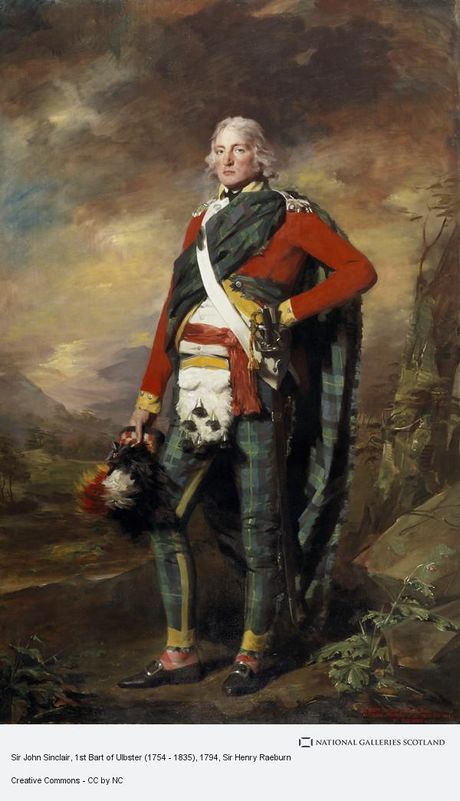Annotation:Sir John Sinclair: Difference between revisions
No edit summary |
No edit summary |
||
| Line 11: | Line 11: | ||
{{break}} | {{break}} | ||
'''SIR JOHN SINCLAIR.''' Scottish, Air (whole time). E Flat Major. Standard tuning (fiddle). AABB. "Very ancient” (Gow). There have been many Sir John Sinclairs in Scottish history, and since Gow labels the tune “very ancient” it is supposed that it referred to a prior Sir John. However, the Sir John Sinclair (of Ulbster, 1754-1835) of Gow’s time was a famous Member of Parliament for Caithness at Westminster, and a man of great intelligence and productivity. He is depicted below by the famous artist Henry Raeburn, probably in his uniform as Colonel of the Caithness and Rothesay Fencibles, a local Highland unit raised for defense during the Wars with France. He was an improver, statistician, agriculturist, ambassador and politician and his public laurels included presidencies of the Highland Society and of the Board of Agriculture and Privy Councillor. | '''SIR JOHN SINCLAIR.''' Scottish, Air (whole time). E Flat Major. Standard tuning (fiddle). AABB. "Very ancient” (Gow). There have been many Sir John Sinclairs in Scottish history, and since Gow labels the tune “very ancient” it is supposed that it referred to a prior Sir John. However, the Sir John Sinclair (of Ulbster, 1754-1835) of Gow’s time was a famous Member of Parliament for Caithness at Westminster, and a man of great intelligence and productivity. He is depicted below by the famous artist Henry Raeburn, probably in his uniform as Colonel of the Caithness and Rothesay Fencibles, a local Highland unit raised for defense during the Wars with France. He was an improver, statistician, agriculturist, ambassador and politician and his public laurels included presidencies of the Highland Society and of the Board of Agriculture and Privy Councillor. | ||
[[File: | [[File:Sinclair2.jpg|460px|thumb|right|Sir John Sinclair, by Henry Raeburn (1794)]] | ||
{{break|2}} | {{break|2}} | ||
</div> | </div> | ||
Revision as of 00:02, 22 October 2019
X:1 T:Sir John Sinclair M:C L:1/8 R:Air N:”Very Ancient” Z:AK/Fiddler’s Companion K:Fdor z|~F2 G>A cAAf|~F2 G>A .c.Az:|c|f>e dc dc A>c| ~f>edc dA ze|fe dc de !fermata!f>g/2a/4|F2 G>A cAAf|F2 ~G>A cA z:|]
SIR JOHN SINCLAIR. Scottish, Air (whole time). E Flat Major. Standard tuning (fiddle). AABB. "Very ancient” (Gow). There have been many Sir John Sinclairs in Scottish history, and since Gow labels the tune “very ancient” it is supposed that it referred to a prior Sir John. However, the Sir John Sinclair (of Ulbster, 1754-1835) of Gow’s time was a famous Member of Parliament for Caithness at Westminster, and a man of great intelligence and productivity. He is depicted below by the famous artist Henry Raeburn, probably in his uniform as Colonel of the Caithness and Rothesay Fencibles, a local Highland unit raised for defense during the Wars with France. He was an improver, statistician, agriculturist, ambassador and politician and his public laurels included presidencies of the Highland Society and of the Board of Agriculture and Privy Councillor.

